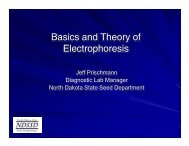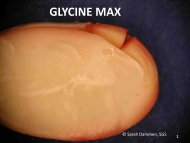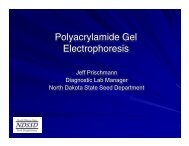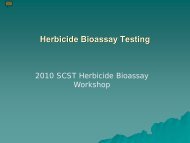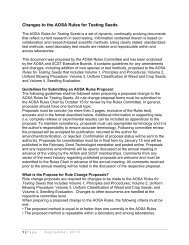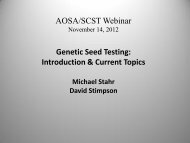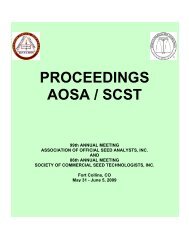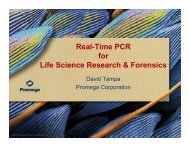Starch Gel Electrophoresis Techniques
Starch Gel Electrophoresis Techniques
Starch Gel Electrophoresis Techniques
You also want an ePaper? Increase the reach of your titles
YUMPU automatically turns print PDFs into web optimized ePapers that Google loves.
<strong>Starch</strong> <strong>Gel</strong> <strong>Electrophoresis</strong><br />
<strong>Techniques</strong><br />
Carol Betzel, RGT<br />
<strong>Electrophoresis</strong> Lab Supervisor<br />
BioDiagnostics, Inc.<br />
River Falls, WI
Reference Manual<br />
<strong>Techniques</strong> and Scoring Procedures for<br />
<strong>Starch</strong> <strong>Gel</strong> <strong>Electrophoresis</strong> of Enzymes<br />
from Maize (Zea mays L.)<br />
C. W. Stuber<br />
J. F. Wendel<br />
M. M. Goodman<br />
J. S. C. Smith<br />
Technical Bulletin 286<br />
March 1988<br />
North Carolina Agricultural Research Service<br />
North Carolina State University<br />
Raleigh, North Carolina
What is <strong>Starch</strong> <strong>Gel</strong> Isozyme<br />
<strong>Electrophoresis</strong>?<br />
Isozyme=Protein<br />
Proteins are charged molecules<br />
Isozyme <strong>Electrophoresis</strong> is a technique of<br />
separating multiple forms of an enzyme<br />
(isozymes) from each other<br />
A starch gel is the matrix in which the<br />
molecules are separated when an electrical<br />
field is applied
What are Isozymes?<br />
<br />
Isozymes are multiple molecular forms of<br />
specific enzymes<br />
<br />
A single gene determines each molecular<br />
form of an isozyme<br />
<br />
The occurrence of different forms of an<br />
isozyme is governed by simple Mendelian<br />
Genetics
Reference Manual Contents<br />
<br />
<br />
<br />
<br />
<br />
Equipment<br />
<br />
Sample prep, gel trays, slicing apparatus<br />
Procedures<br />
<br />
<br />
<br />
Sample and gel prep<br />
<strong>Gel</strong> and staining solution recipes<br />
Enzyme systems<br />
Scoring Procedures; common nomenclature<br />
References<br />
List of supplies
<strong>Gel</strong> Mold
Maize Chromosome Map<br />
Each gene had been mapped to a locus.
<strong>Gel</strong> Making<br />
Determine gel system needed<br />
Single or multiple gels: # of loci needed<br />
Need consistent starch product<br />
Need consistent taring and gel making<br />
procedures
“B” <strong>Gel</strong> Ingredients<br />
L-histidine pH 5.7
Trouble Shooting for <strong>Gel</strong><br />
Quality<br />
Water quality<br />
pH<br />
<strong>Starch</strong> source (hydrolyzed starch)<br />
<strong>Starch</strong> and sucrose amounts<br />
Proper gel preparation procedures
<strong>Gel</strong> Mold
<strong>Gel</strong> Mold with Open “Legs”
<strong>Gel</strong> Mold—Taping
<strong>Gel</strong> Mold—Taped
Pouring the <strong>Gel</strong>
Sample Preparation<br />
Coleoptile<br />
Leaf<br />
Brace root<br />
Pollen<br />
(Seed used in IEF)
Harvesting Coleoptile Tissue<br />
REPRESENTATIVE SAMPLE IS CRITICAL!<br />
DON’T SKIP THE SMALL COLEOPTILES!
Sample Preparation<br />
Use control with a known banding<br />
pattern<br />
Use female and male controls for<br />
hybrids—not needed if previously tested<br />
and banding patterns are recorded in a<br />
database
Extraction Buffer<br />
Releases proteins from tissue<br />
Homogenizes the tissue sample
Add to<br />
each<br />
well<br />
Extraction Buffer
Use to<br />
crush<br />
seedlings<br />
Crusher
Releases<br />
proteins<br />
from<br />
tissue<br />
Crushing Coleoptiles
Paper Wick
Loading <strong>Gel</strong>s<br />
Sample absorbed onto paper wick is<br />
inserted into gel<br />
Important to keep lanes in correct order<br />
when loading<br />
Documentation of loaded samples is<br />
critical
Samples From One Seed Lot
Remove<br />
tape<br />
from gel<br />
mold leg<br />
Removing Tape from <strong>Gel</strong> Mold
Cut off<br />
meniscus<br />
Leveling <strong>Gel</strong> Top
Cut slit<br />
to insert<br />
wick<br />
Loading <strong>Gel</strong>
Inset<br />
wick—<br />
section 1<br />
Loading <strong>Gel</strong>
Inset<br />
wick—<br />
section<br />
2<br />
Loading <strong>Gel</strong>
<strong>Gel</strong> loading<br />
completed;<br />
insert<br />
marker dye<br />
to measure<br />
migration<br />
distance<br />
Loaded <strong>Gel</strong>
Running the <strong>Gel</strong><br />
Electrical power source<br />
Electrodes, + and – charge<br />
Choose constant:<br />
<br />
<br />
<br />
Milliamps (Current)<br />
Watts (Power) or<br />
Volts (Voltage)
Ohm’s Law<br />
<br />
<br />
I=E/R<br />
<br />
Electric current is directly proportional to voltage<br />
and inversely proportional to resistance<br />
Electrical Parameters<br />
<br />
<br />
<br />
<br />
I = Currant (amps)<br />
E = Voltage (volts)<br />
R = Resistance (ohms)<br />
P = Power (watts)
Fill<br />
buffer<br />
trays<br />
Running the <strong>Gel</strong>
Place<br />
gel mold<br />
in buffer<br />
trays<br />
Running the <strong>Gel</strong>
Running the <strong>Gel</strong><br />
Connect<br />
to<br />
electrical<br />
leads;<br />
Positive<br />
+ and<br />
Negative<br />
- charge
Set upper<br />
limit for<br />
desired<br />
constant<br />
and run gel<br />
for several<br />
hours to<br />
separate<br />
bands<br />
Running the <strong>Gel</strong>
Before <strong>Electrophoresis</strong><br />
Proteins are polarized molecules<br />
Origin
After <strong>Electrophoresis</strong><br />
origin<br />
<strong>Gel</strong> acts as a sieve; molecules move through and<br />
separate in electric field
Running the <strong>Gel</strong><br />
<br />
Speed of migration determined by<br />
<br />
<br />
<br />
<br />
<br />
<br />
<br />
<br />
Temperature<br />
Density of gel<br />
Setting of mAmps, Watts, or Volts<br />
Type of buffer<br />
pH of gel<br />
Concentration of buffer<br />
Molecular size and shape of proteins<br />
Net charges
Running the <strong>Gel</strong><br />
Need to keep the gel cold or:<br />
<br />
<br />
<br />
<br />
Proteins will degrade<br />
Bands will appear distorted<br />
Bands will diffuse<br />
Loss of enzymatic activity
Slicing the <strong>Gel</strong><br />
<br />
<br />
Slice gel into several separate slices<br />
Each slice is stained with a different protein<br />
specific stain. Examples:<br />
ACP Acid phosphatase<br />
ADH Alcohol dehydrogenase<br />
GLU β-glucosidase<br />
IDH Isocitrate dehydrogenase<br />
MDH Malate dehydrogenase<br />
PGD 6-phosogluconate dehydrogenase<br />
PGM Phosphoglucomutase
Slicing the <strong>Gel</strong><br />
<br />
Additional stains.<br />
ACO Aconitase<br />
AMP Arginine aminopeptidase<br />
CAT Catalase<br />
DIA Diaphorase<br />
ENP Endopeptidase<br />
EST Esterase<br />
GOT Glutamate-oxaloacetate transaminase<br />
PHI Phosphohexose isomerase<br />
SAD Shikimic acid dehydrogenase
Cut notch in<br />
corner for<br />
orientation<br />
Removing <strong>Gel</strong> from Mold
Removing gel from mold
Removing <strong>Gel</strong> from Mold
Draw<br />
wire<br />
through<br />
gel<br />
Slicing the <strong>Gel</strong>
Remove<br />
plastic<br />
strip on<br />
each<br />
side of<br />
gel<br />
Slicing the <strong>Gel</strong>
Draw<br />
wire<br />
through<br />
gel<br />
again;<br />
repeat<br />
process<br />
to get<br />
several<br />
layers<br />
Slicing the <strong>Gel</strong>
Transfering <strong>Gel</strong> Slice<br />
Lay piece<br />
of filter<br />
paper on<br />
gel slice<br />
and lift
Place gel<br />
slice in<br />
staining<br />
tray<br />
Transfering <strong>Gel</strong> Slice
Staining <strong>Gel</strong>s<br />
Know your chemical MSDS for safety<br />
Proper chemical and concentrations<br />
preparation<br />
Incubation times and conditions<br />
Slice sequences and thickness
Staining the <strong>Gel</strong><br />
Reveals zones of enzymatic activity as bands.<br />
Bands observed on a gel after staining represents<br />
multiple forms of an enzyme.
Stained <strong>Gel</strong> Slice<br />
ACP<br />
Acid phosphatase
Stained <strong>Gel</strong> Slice<br />
MDH<br />
Malate dehydrogenase
Seven<br />
stained<br />
gel slices<br />
from one<br />
gel; with<br />
seven<br />
different<br />
enzyme<br />
specific<br />
stains<br />
Stained <strong>Gel</strong> Slices
Why Corn?<br />
<br />
<br />
<br />
<br />
Highly polymorphic (more than one form or<br />
banding pattern at a locus)<br />
Suitable for high throughput<br />
Sample preparation fairly simple<br />
Data very useful for:<br />
<br />
<br />
<br />
Hybrid production: % selfs, off-types, variants<br />
Inbred production: % off-types, variants,<br />
segregation<br />
Breeder’s seed: homozygous or segregating ears
Sweet Corn is Good to Eat!<br />
And also can be<br />
tested on a<br />
starch gel—so<br />
can popcorn!<br />
But can’t test candy corn ☹
Other Crops<br />
<br />
Canola<br />
PHI<br />
ACO<br />
<br />
Sunflowers<br />
PHI PGD PGM
Other Crops<br />
<br />
Sorghum<br />
PHI<br />
CAT<br />
<br />
Soybeans<br />
DIA
PROS<br />
<br />
<br />
<br />
<br />
<br />
<br />
<br />
<br />
Quick turn around time for results<br />
High throughput<br />
Gives strong data genotypically of corn, etc<br />
Isozyme <strong>Electrophoresis</strong> results cannot be masked by<br />
environmental effects<br />
<strong>Starch</strong> matrix is suitable for isozymes to travel<br />
through and can get more than one slice from a gel<br />
Non-toxic<br />
Fairly inexpensive equipment<br />
Powerful ID: may be able to identify seed mixes or<br />
incorrect labeled samples if suspect variety previously<br />
tested
CONS<br />
<br />
<br />
<br />
<br />
<br />
<br />
What may be an offtype on the gel may or may not<br />
be expressed phenotypically<br />
Must be live tissue to extract isozymes<br />
Not all tissues of corn band out the same; and some<br />
enzymes are not expressed in leaf and brace root<br />
tissue<br />
Not suitable for scanning or long term storing gels<br />
<strong>Starch</strong> and chemical supply/demand issues<br />
Limited number of loci tested; may not be able to<br />
detect selfing in some hybrids
Field vs Lab test<br />
Variant or offtype may be an<br />
insignificant agronomic characteristic<br />
Environmental factors can affect plant<br />
appearance<br />
Generally a correlation between field<br />
growouts and electrophoresis data
Applications<br />
Know seed quality before conditioning<br />
and delivering seed to customer<br />
<br />
Less than 2 week, vs. grow outs<br />
Improve inbred uniformity<br />
Verify varieties<br />
Can test brace roots from field samples<br />
to help identify problems
Applications<br />
Breeder’s seed<br />
<br />
Eliminate segregating lines<br />
<br />
If 2 loci are segregating, could develop 4 new<br />
homozygous lines:<br />
ACP1: 2/2,2/4,4/4 MDH2: 3/3,3/6,6/6<br />
<br />
<br />
<br />
<br />
Type A: ACP1=2/2; MDH2=3/3<br />
Type B: ACP1=2/2; MDH2=6/6<br />
Type C: ACP1=4/4; MDH2=3/3<br />
Type D: ACP1=4/4; MDH2=6/6
Questions?<br />
.



